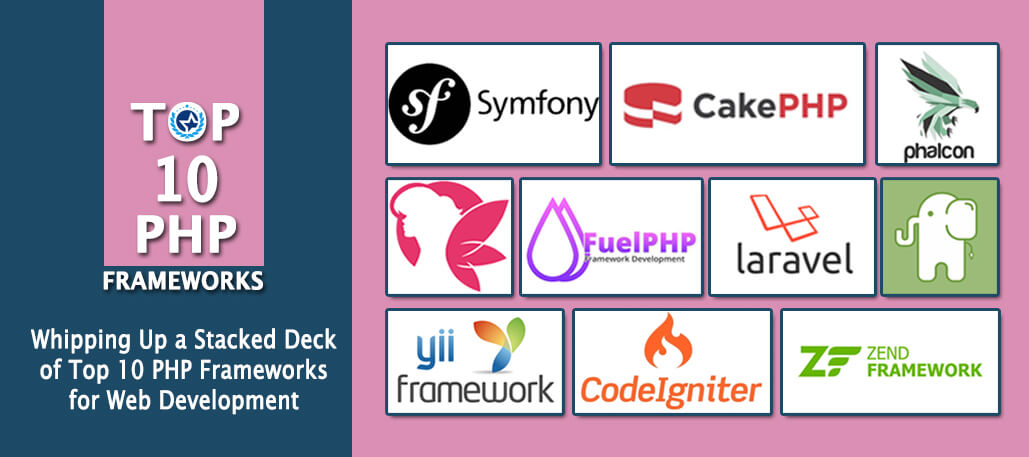
Whipping Up a Stacked Deck of Top 10 PHP Frameworks for Web Development
Top Website Development Companies scramble for ways to fight fresh coding challenge with the advent of PHP frameworks ’19!
Sometimes hard development options (read: Core PHP) is a risk worth taking. Development teams have to make the finer choice to ease out their development tasks by replaceable twins. Prevalent options in PHP frameworks are the first thing that has made a difference to PHP programming. The transformation of the journey is although unusual but swift. It is the reason why top PHP developers are keenly connected with best programming practices in PHP.
Because of the huge popularity of PHP, it has almost become impossible for web developers to ignore PHP. Working knowledge of PHP always helps, even if it is used along with frameworks. Here is a list of top PHP frameworks that are lined up in 2019 – will help speed up proficiency, make code responsive, cleaner and more optimized for performance.
A quick look at some tips that every PHP developer must practice during their coding:
- Making use of SQL injection cheat-sheet
- Knowing when and how to use comparison operators
- Initialize variables before using them; else should not be skipped
- Drop the brackets
- str_replace() must be favored instead of ereg_replace() and preg_replace()
- Ternary operators must be used
- Local memory must be utilized, in order to process the applications quickly
- Making use of the framework, as all decision have consequence
- Making correct use of suppression operator
- Making use of isset() instead of strlen()
Here is a list of 10 top PHP Frameworks (in no particular order) that are going to rule PHP Development in 2019:
1. Slim
Slimor Slean as it is called is a powerful PHP framework that helps write powerful PHP applications and API’s. It comes with a powerful HTTP router, a concentric middleware to tweak the HTTP request, PSR-7 HTTP and support for dependency injection. It is a micro framework that eases quick development, is lightweight and can be used for making both small and large websites.
2. PHPixie
PHPixie is a modern, fast and secure PHP framework that is easy to learn and does not rely on automagic. It is flexible enough and easy for both experienced as well as naïve PHP programmers. It comes with a bundle system, MongoDB support, hardened security, linear code flow, is designed from scratch according to some solid principles and industry standards. With approximately 800 daily downloads and 517 stars on Github, it ranks 6th according to Sitepoint’s 2015 popularity poll.
3. FuelPHP
It is an open source MVC framework that implements an HMVC pattern for web application development. It comes with ViewModels that adds a layer between the controller and the View. Based on PHP 5.4+ framework, FuelPHP is fast and simple.
4. Phalcon
Based on MVC, Phalcon is a PHP web framework that is easy to install, is highly extensible – it is a full stack PHP framework that is delivered as a C-extension. Low overhead, dependency injection, REST, Autoloader, router are some other features that come aligned with Phalcon.
5. Zend Framework
Zend Framework (particularly version 3) runs up to 4x faster than version 2 release. It makes code re-usability easier. It makes efficient use of object-oriented principles, libraries, models, and documentation. Based on open-system architecture (Middleware or MVC) and follows PHP-FIG standards. It stores passwords using bcrypt, encrypt with AES-256 and more. It suits well for business critical and high usage applications. It is enterprise ready for PHP7.
6. Yii
Yii is fast, secure, and efficient, MVC framework that is simple to implement Security, Short Development Time, Swift Error Handling, log-in and making use of theme, is highly extensible and very easy to install.
7. CakePHP
CakePHP is modeled after Ruby on Rails, follows the model-view-controller approach and is an open-source framework. It is 100% backward compatible and upgradable. CakePHP applications require less code. These are simple, fast and effective. These applications do not require any complex XML configuration. There are built in Translations, database access, caching, validation, authentication, built-in tools for input validation, CSRF protection, SQL injection prevention, Form tampering protection, and XSS prevention. There are scaffolding features to rapidly prototype. Its codebase has been audited through Mozilla Secure Open Source program.
8. Symfony
It is a set of reusable components/libraries in PHP. It is reliable, flexible, testable, and supports long term applications – the latest stable release is 4.2. Although it is not a very trendy framework it is most suitable for large, enterprise applications. It was built to replace coding iterations and is available as freeware. It is optimizable and scalable.
9. Codeigniter
It is most suited for web applications with advanced features. It welcomes webpages with minimal scripting. It can easily be adopted with naïve programmers who do not have much knowledge of object-oriented programming. It is very small in size as compared to Laravel and Symphony. It offers controllers and libraries for logic, views for HTML, models for data. Besides this, it is based on MVC architecture. There are no server requirements, is easily expandable, has built-in libraries and security tools. It has a large community of active users.
10. Laravel
It is one of the most favored PHP frameworks, that supports object-oriented programming, MVC architecture, auto-loading facility, authentication, and version control. PHP developers can impose constraints when using multiple database objects by making use of advanced query builder mechanism with Laravel.
Decisional
Selecting a PHP framework for developing web application can be tiresome in case of improper planning. Top PHP Developers keep thinking about ways to build applications in the least possible time. Having a framework that facilitates in-built tools and libraries, has community support, is scalable, easy to learn, and has support for advanced features and well-designed toolkit – is preferred over its counterparts. The final choice lies in the hands of developers who have to select the framework according to their requirements.
